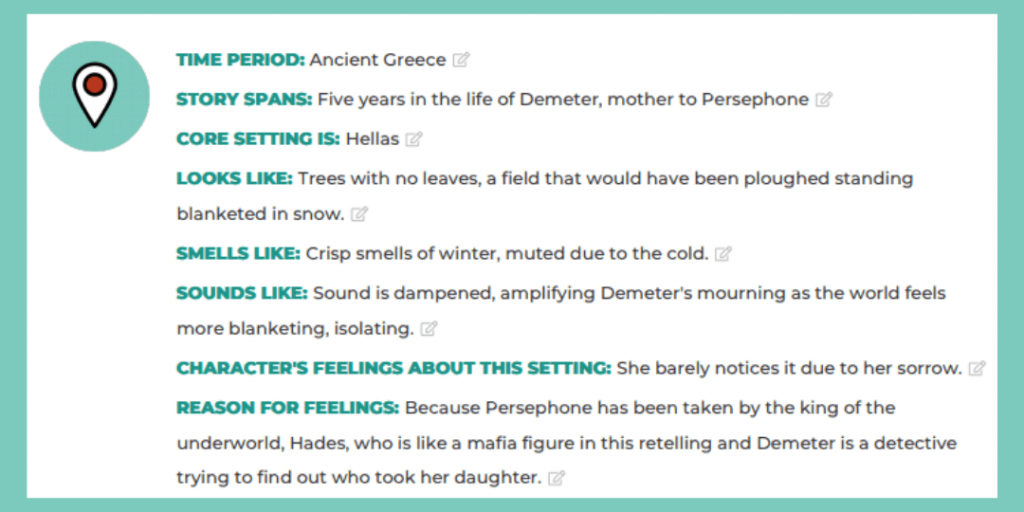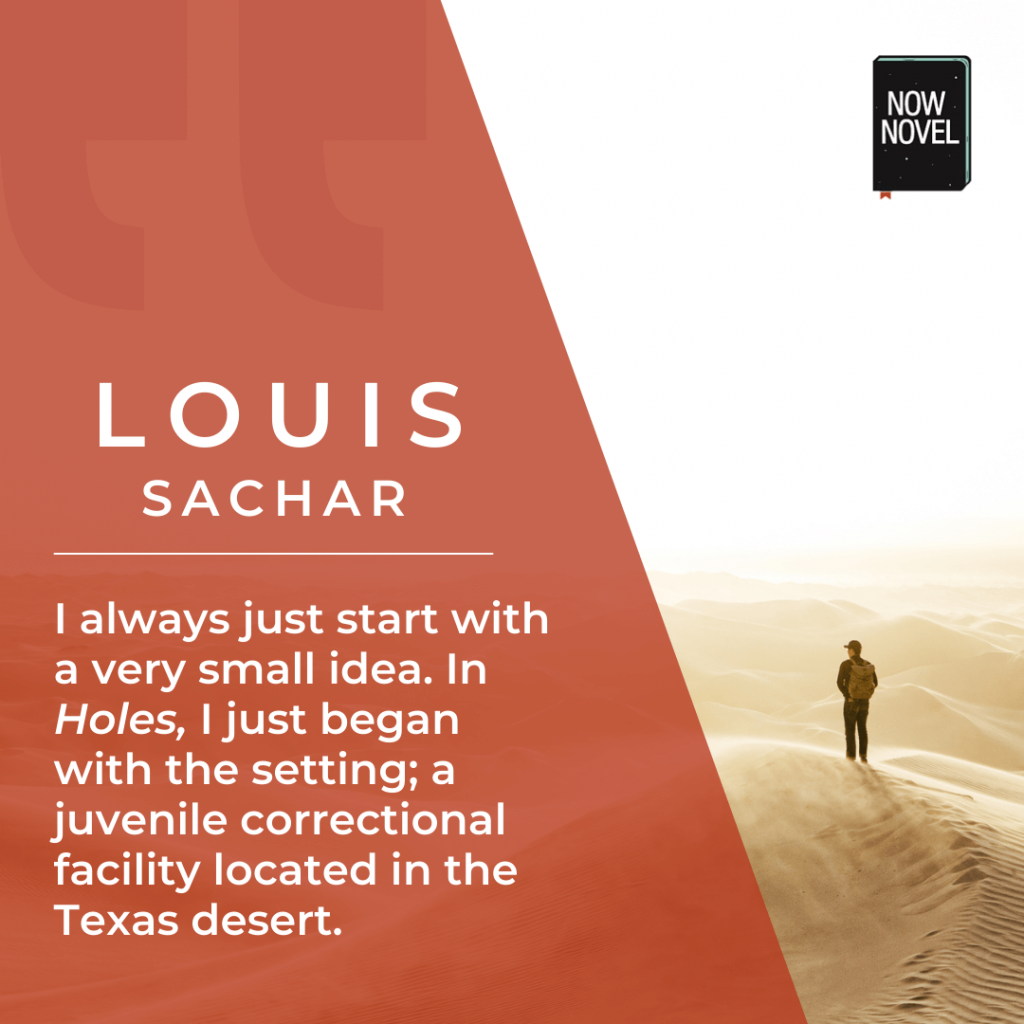Strong story setting ideas are easy to find. Story setting examples by authors who write brilliant description supply many insights. Here are 7 ways to immerse your readers in place and time:
7 story setting ideas to try:
- Use the seasons or weather for mood
- Tie periods of your story to places
- Include the sounds of your world
- Make setting characters’ stage
- Find suspense in your settings
- Make familiar places novel via viewpoint
- Make each location detailed and alive
Let’s examine these ideas for creating richly detailed place and time further:
1. Use the seasons or weather for mood
The seasons and the weather have long been used to suggest tone and mood in stories.
In Ancient Greek mythology, the myth of Persephone explains why we have winter. Persephone, abducted by the king of the underworld, must stay with him for the months of the year that coincide with winter.
During these months, her mother Demeter (the Goddess of the harvest) mourns her absence. This myth thus explains why the seasons change.
The association in this myth between mourning and an element of setting – the icy cold of winter – is one example of how environment in a story creates or reinforces specific emotions, tone and mood.
If you were writing a modern retelling of this myth, you could outline the wintry setting Demeter wanders. This would help you find scene ideas and further details:

Example of seasonal setting by Arundhati Roy
Setting – place – is evocative in Arundhati Roy’s Booker-winning novel The God of Small Things. Roy begins the novel by describing the stultifying heat of a core location, the village of Ayemenem in Kerala, India:
May in Ayemenem is a hot, brooding month. The days are long and humid. The river shrinks and black crows gorge on bright mangoes in still, dustgreen trees. Red bananas ripen. Jackfruits burst. Dissolute bluebottles hum vacuously in the fruity air. Then they stun themselves against clear windowpanes and die, fatly baffled in the sun.
Arundhati Roy, The God of Small Things (1997), p. 1.
Roy takes a story opening focus as old as ancient myth – beginning with the weather – and turns it into rich, evocative setting that suggests both abundance (bursting ripe fruit) and death.
Season and weather set the tone for a novel that explores bursting life and devastating loss, constantly intertwining both.
2. Tie periods of your story to places
What is setting? Simply put: Time and place. When and where.
These are broad categories, though. The time could be 5 a.m. somewhere in Cambodia or the time of the pharoahs; a time of locusts.
Settings grow more interesting the more specific we get. This house, on that street. The strange mix of eras in its architecture, where an ugly 80s facebrick extension was tacked onto Victorian grandeur.
Times, eras, occupants (and remnants of their tastes) overlap, to create one of setting’s interesting elements: history.
When you’re brainstorming story setting ideas, ask:
- How does this place affect my character (how does it make them feel)?
- What places would this character love to go (parks, museums, libraries, graveyards) – why?
- Which places do they frequent or haunt – what are people’s place-attachments, and what histories do they stem from?
- What places do they fear, avoid, or never want to see again?
What periods of your characters’ lives are spent in which places?
How does this shape their views, identities or experiences?
Example of tying a period of a story to place: Colum McCann
Colum McCann is an esteemed fiction writing coach (having taught in the MFA program at Hunter’s College alongside Peter Carey) and author. His book Dancer fictionalizes the life of the famed ballet dancer Rudolf Nureyev, he describes Nureyev’s first ballet season in Paris, in 1961:
Edith Piaf was watching from the veranda. Jean Cocteau smiled from the shadows. Marlene Dietrich was stretched out on the divan. There was a rumour of Leonard Bernstein on his way from his hotel, perhaps even an apperance by Picasso. Someone began quoting lines from Proust. All for me!
Column McCann, Dancer, p. 171.
Here, McCann cleverly ties this period in Nureyev’s rise on the world stage to the specific period in Paris’ artistic life. He shows glimpses of famous figures of art, music, literature and film who would have been around during this era.
McCann contrasts details supplying the ‘cultural moment’ or era of Paris in 1961 with specific Parisian locations. In describing soirees at a grand house, he shows decadence suggestive of Nureyev’s rise to acclaim and higher status:
The de la Rochefoucauld house – fifteen types of champagne, more caviar than ever seen before. Orchids on the tables. Gold candelabras. Everyone was whirling around, the room had no corners. The talk was of choreographers, critics, audiences…
McCann, pp 171-172.
Thus McCann provides both broad and detailed elements of setting, adding depth.
3. Include the sounds of your world
Story setting ideas should include what your world sounds like.
Picture a Tibetan monastery high in snowy foothills. What can you hear?
Sound is an important part of setting because sounds in setting enhance:
- Mood: The tense mood of a sudden gunshot ringing out, for example, or the calm reverberating of a struck gong
- Emotion: The haunting sounds of the dying on a battlefield, after the clashing armies have left
- Immersion: Details that place your reader in a scene. For example, the rustling and chirruping of undergrowth and canopy in a forest
Example of using sounds in setting: Chimamanda Ngozi Adichie
In Nigerian author Chimamanda Ngozi Adichie’s award-winning novel Half of a Yellow Sun, setting descriptions supply sensory richness.
At the start, a boy named Ugwu is taken by his aunt to become a cleaner or ‘houseboy’ for a university lecturer.
Adichie describes their walk to the professor’s rooms:
His aunty walked faster, her slippers making slap-slap sounds that echoed in the silent street. Ugwu wondered if she, too, could feel the coal tar getting hotter underneath, through her thin soles.
Chimamanda Ngozi Adichie, Half of a Yellow Sun (2006), p. 3
Adichie puts us right in the scene, using onomatopoeia (sound-words) to create the sound of the boy’s aunt’s slippers.
Develop immersive settings
Develop immersive story settings and outline their details in the Now Novel dashboard.
LEARN MORE
4. Make setting characters’ stage
Setting is your characters’ stage.
When you brainstorm scene ideas for your story, ask:
- Where could this scene take place?
- What would happen if I move this scene to that setting (e.g. setting a first kiss at a bus stop, versus in the woods)
- How can I bring the setting into the action of my scene?
Example of using setting for good staging: Amitav Ghosh
Amitav Ghosh begins his novel The Hungry Tide on a crowded station platform.
The main character Kanai is intrigued by a foreigner with short-cropped hair who looks out of place:
Why would a foreigner, a young woman, be standing in a south Kolkata commuter station, waiting for the train to Canning? It was true of course that this line was the only rail connection to the Sundarbans. But so far as he knew it was never used by tourists – the few who travelled in that direction usually went by boat, hiring steamers or launches on Kolkata’s riverfront.
Amitav Ghosh, The Hungry Tide (2004), pp. 2-3.
By showing Kanai observing the woman at the platform, and the way she stands out to Kanai and creates intrigue and mystery, Ghosh draws us into the story.
The way the characters are staged around a train platform setting to begin creates questions involving motive, travel, destination, purpose.
5. Find suspense in your settings
As you brainstorm individual story locations, look for ways settings create suspense.
For example, a house, as a story setting, provides moments for suspense such as:
- knocking on the door
- a telephone’s ring
- unexpected sounds
- narration shifting the focus to another area (e.g. ‘meanwhile, upstairs…’)
Micro moments of suspense are what hook us as we read, making us ask ‘who’, ‘what’, ‘why’, ‘where’, and ‘when’.
[Get feedback on pacing, suspense and more from our experienced writing coaches.]
Example of finding suspense in setting: Colm Tóibín
In Colm Tóibín’s novel Brooklyn, the first chapter describes a sister watching her sibling from the upstairs window as she arrives home.
Notice how staging within the house (upstairs/downstairs, arrival) creates subtle suspense:
As soon as she heard the front door open, Eilis went downstairs. Rose, in the hall, was holding her pocket mirror in front of her face. She was studying herself closely as she applied lipstick and eye make-up before glancing at at her overall appearance in the large hal mirror, settling her hair.
Colm Tóibín, Brooklyn (2009), p. 3
The home setting provides opportunities for suspenseful arrival and departure.
Where is Eilis’ sister coming from that she applies makeup the second she arrives home (or where is she heading out again)? Why was Eilis watching her from the upstairs window, too? Does she suspect her of something?
6. Make familiar places novel via viewpoint
There are many story setting ideas when you’re writing realist fiction to take from real life.
Famous galleries, museums, featured of landscape and geography. Rivers and lakes, mountains and forests.
How do you turn story setting ideas taken from life into fresh story locations?
Make familiar places novel via characters’ viewpoints. For a setting such as the Seine river, for example, ask:
- What memories does my character associate with this place or landmark?
- Where does this place lie in relation to other locations in the story?
- What of intrigue, surprise or wonder might happen here?
Mapping your story and characters’ experiences and memories to setting in this way will help to make your story’s world feel lived in.
Example of making familiar settings novel: Colum McCann
Colum McCann’s novel This Side of Brightness details the digging of the tunnel beneath the Hudson river between Brooklyn and Manhattan.
The Hudson may be a famous New York landmark, but McCann makes it novel through his character’s eyes and experiences:
On the evening before the first snow fell, he saw a large bird frozen in the waters of the Hudson River. He knew it must have been a goose or a heron, but he decided that it was a crane. Its neck was tucked under its wingpit and the head was submerged in the river. He peered down at the water’s surface and imagined the ancient ornamental beak.
Colum McCann, This Side of Brightness (1998), p. 1
Here, McCann gives us a unique view of the Hudson via his character’s eyes.
A specific, precise and unusual image in this familiar setting is suggestive of both danger and fragility. This connects thematically with the idea of the tunnel that will be dug beneath the river.
7. Make each location detailed and alive
When you find story setting ideas, try to pinpoint specific details. If you’re writing about a kitchen, what spices are on the rack? What are the counters made of? How tidy or unkempt is the floor?
Specific details, sounds and colours, bring a story into three dimensions.
Example of detailed, alive setting: Jhumpa Lahiri
In Jhumpa Lahiri’s Pulitzer-winning novel The Namesake, the opening page gives us a detailed, lived-in description of a kitchen:
On a sticky August evening two weeks before her due date, Ashima Ganguli stands in the kitchen of a Central Square apartment, combining Rice Krispies and Planters peanuts and chopped red onion in a bowl. She adds salt, lemon juice, thin slices of green chili pepper, wishing there were mustard oil to pour into the mix.
Jhumpa Lahiri, The Namesake (2003), p. 1.
Lahiri’s opening page gives a good example of how to turn story setting ideas (‘a kitchen’) into vibrant spaces alive with character and identity.
Concerned whether your setting is immersive enough? Work 1-on-1 with a fiction writing coach, book online consults at mutually convenient times, and get structured support for finishing your stories.



